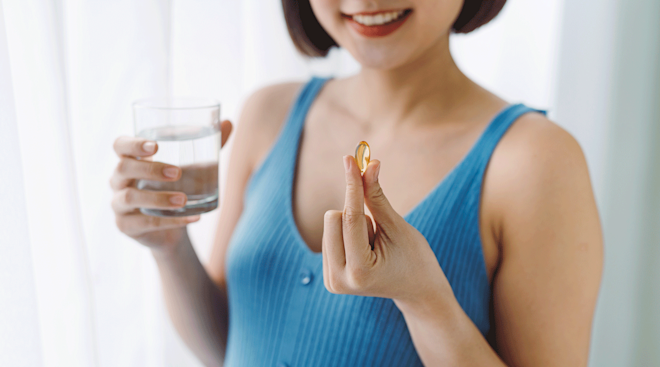- Congrats! You've reached the finish line. Babies born at 39 weeks are considered full term, so go ahead and let your little squatter know that they’re being evicted. (Your hospital bag is packed, right?)
- Yes, technically you're due at 40 weeks. But if you have gestational diabetes, preeclampsia or another condition that puts you or baby at risk, your ob-gyn might encourage an induction.
- Contractions are the name of the game at this late stage. You’ll feel your belly hardening throughout the day—especially when you’ve been physically active. If you notice that the contractions are getting more intense and more frequent, it may be go time! Be sure to brush up on the other signs of labor below!
You’re probably feeling like you want to get this baby OUT. We’re not sure, but the impatience and discomfort moms-to-be feel around 39 weeks pregnant (and beyond!) might be nature’s way of getting you mentally prepared for delivery. At week 39 of pregnancy, you don’t care what it takes, you just don’t want to be pregnant anymore!
Inside your 39 weeks pregnant belly, baby is probably able to flex their limbs now. Baby's brain is still rapidly developing—they’re getting smarter by the week! Baby's nails may extend beyond the fingertips now.
Believe it or not, baby’s skin is actually changing quite a bit this week: not only is it growing a layer of fat underneath the outer layer to help them regulate their body temperature and stay warm (they’re about to leave the nice, cozy womb, remember?), the skin itself is hardening and growing a tougher, more solid layer that’s no longer translucent. This will also help them regulate their body temperature, as well as protect them from injury.
Baby should still be moving around in your womb at 39 weeks; the myth that babies move less as the labor process gets going isn’t true. However, the type of movement you feel will likely be different, thanks to how little room baby has in there!
Instead of kicks, flips and twists, you might feel more rolling movement, or you may even feel baby attempting to stretch, turn or get comfortable in their cramped quarters. It can be harder to “count kicks” at this point, but you can still keep track of the number of times you feel your little one moving around (it should be about 10 movements every one to two hours).
How big is baby at 39 weeks?
At 39 weeks pregnant, baby is as big as a pumpkin. Your 39-week fetus measures about 20 inches long and likely weighs between 7.5 and 8 pounds. Suffice it to say, baby is crowded inside your 39 weeks pregnant belly.
39 weeks pregnant is how many months?
No surprise here: 39 weeks pregnant is nine months pregnant. Next week, you’ll wrap up this final month of pregnancy and reach your due date (that is, if you don’t go into labor this week). Can you handle the suspense?!
39 week ultrasound
At 39 weeks pregnant, an ultrasound and non-stress test might be in order to check on baby’s well-being—especially if you’re 39 weeks pregnant with twins. After seeing the results of these two tests, your doctor might say everything looks fine, or they might recommend an early delivery.
Really, there’s nothing left to do except see the doctor each week, wait for baby and keep your mind busy with little tasks. If they get done, great. If not, no biggie. We know it’s tough to relax, but try!
Typical 39 weeks pregnant symptoms—the ones that aren’t signs that labor is happening now—are similar to what you’ve been experiencing the past few weeks. Most are signs that labor will happen soon, though. These include:
Braxton Hicks contractions
At 39 weeks pregnant, cramping or tightening of your uterus may seem pretty constant, no matter what you do. Usually these “practice” labor pains start in the front of your body and ease up when you switch positions. You'll know it's real labor when they start at the top of your uterus and become more frequent and regular.
Pelvic pressure
While getting into position for birth, baby may be sitting so low that your lower torso feels heavy and uncomfortable.
Lightning crotch
Because baby is so low, their movements can hit some sensitive nerves, giving you sharp sensations in your pelvis and vagina—yep, like a lightning bolt! Yowch!
Urge to nest
Some moms-to-be say they get a surge of energy and a strong desire to clean their home right before baby’s debut. Don’t go too crazy, though. You don’t want to wear yourself out before the birth.
Mucus plug and/or bloody show
At 39 weeks pregnant, discharge that’s as thick as mucus and sometimes has a tinge of blood in it is your mucus plug. (The blood is, you guessed it, the bloody show.) And while many people consider this to be a sign you’ll go into labor soon, there’s no exact science to it. In other words, it might still be a bit!
What should I be feeling at 39 weeks pregnant?
Probably a little bit of everything! You’re likely cycling through a lot of the 39 weeks pregnant symptoms. One moment you’re racing around with high energy, accomplishing all your pre-baby chores around the house, and the next you want to just curl up in bed with your body pillow and snooze. You may also be feeling anticipation (OMG, baby’s almost here!) with a little bit of nervousness (OMG, baby’s almost here!). You got this, mama!
If you’re the rare mom-to-be who’s 39 weeks pregnant with twins, kudos to you! You’ve kept those babies baking despite the odds of an early delivery (and despite your all-around discomfort). You’re probably feeling many 39 weeks pregnant symptoms, including the urge to get your twosome out of your 39 weeks pregnant belly and into the world. Don’t worry—the end is so near!
Other symptoms are your body’s way of telling you baby is making their arrival ASAP. At 39 weeks pregnant, the signs of labor are probably on your mind. It’s important to know what they are, but don’t worry too much about going into labor without realizing it. In most cases, labor symptoms will be so strong and so different from what you’ve been experiencing that you won’t be able to ignore them.
Call your OB if you experience either of these:
Water breaking
It might not be like it is in the movies—you might have a slow trickle instead of a huge gush of water. But if at 39 weeks pregnant, your discharge is watery instead of its usual consistency, it may mean your amniotic sac has ruptured and you will likely go into labor within hours.
Regular contractions
If you’re having repetitive and painful tightening in your belly, start timing the contractions. If they keep coming and the time between them keeps getting shorter, you’re in the beginning stage of labor. Just how long this stage lasts will vary from mom to mom (yes, you’ll be a mom very soon!), so keep your provider updated and follow their directions for getting to the hospital by the time you progress into active labor.
When you’re 39 weeks pregnant, no signs of labor may have appeared yet, and that’s fine too! On average, a first-time mom-to-be will go into labor naturally around the 41-week mark, but second-time moms, tends to deliver closer to 40 weeks. And while some women start to show signs of labor—a dilated and/or effaced cervix, regular contractions, etc.—weeks or days before they give birth, others go from zero to 10 centimeters dilated within hours.
Can you be in labor without contractions or water breaking?
Contractions are the body’s way of getting ready for delivery, so you need them to be in labor. (We’re talking real contractions, not the Braxton Hicks kind.) It’s a different story when it comes to your water breaking, which doesn’t happen naturally for all women. If you’ve reached the get-to-the-hospital stage of your contractions and your water hasn’t broken, your doctor may take care of that for you when you get there. If your water breaks and there aren’t any contractions to go along with that, contact your OB, because that can lead to infection risk.
Now that you’re 39 weeks pregnant (full term!) and itching to give birth, you might wonder how to induce labor naturally at home. Gulping down castor oil and taking herbal remedies aren’t considered safe—and eating spicy food just isn’t going to do it. But there are a few things that are typically safe and may work:
Walking
Tie on those sneakers and go for a long, long walk. It’s not a medically proven method of inducing labor at 39 weeks, but some experts believe gravity will push baby down onto your cervix and the pressure will start dilation. (You can also try curb walking!)
Acupuncture
Again, it’s not proven, but there’s some evidence to suggest that this ancient practice regulates blood flow, which stimulates your cervix to dilate.
Having sex
Anecdotally, some people believe that having an orgasm (which you can safely achieve with or without your partner) can help bring on contractions. Couldn’t hurt to try, right?
For some women who are 39 weeks pregnant, the doctor might recommend a medical induction. Reasons for inducing labor include complications (preeclampsia, gestational diabetes, a heart condition), placental problems and infection of the uterus. Induction also may be recommended if you’re 39 weeks pregnant with twins or if your water broke but labor hasn’t started on its own.
Although you may have disturbing visions of your water breaking on aisle nine of the grocery store, fear not! Most women will experience ‘rupture of membranes’ (sounds so dramatic) while actively laboring at their home, hospital or birth center. So walk and shop with confidence. And if there needs to be a clean-up on aisle nine, your birth story will start with a strong opener!
Time is ticking by. You’re ready to go—and baby will be soon! Here’s what you can do this week as you get ready for delivery day!
To shave or not to shave
If you’re asking: Should I shave before birth, know that at this 39-week stage of pregnancy, shaving your pubic hair is a pretty tricky job to pull off! You’ll be glad to know you don’t have to go through the hassle of shaving before giving birth; in fact, if you’re having a C-section, you’re advised not to.
Get cooking
One of the most productive things you can do during your nesting phase is get your kitchen in order. Stock up on pantry essentials and prepare meals that can be frozen now and then reheated after you come home with baby. Trust us, the last thing you’ll want to be doing while you get acquainted with your newborn is grocery shopping and cooking elaborate meals.
Go for a quick dip
At 39 weeks, you probably feel ready to burst at the seams. Take all the pressure and weight off you by going for a swim—check with your provider first to ensure you aren’t dilated. You’ll feel weightless floating in the water, and that can help relieve aches and pains.
Install your car seat
If you haven’t done so already, this is a task you (or your partner) should check off the to-do list before you leave for the hospital. Visit a local inspection station, such as your local police or fire station, to make sure you’ve done the job right!
Get as much sleep as you can
This may be the last week you get to try to sleep through the night for a while, so take advantage of it! Get to bed early and take naps if you need to during the day. You’ll need your strength for the big day!
Frequently Asked Questions
How do I know if it's the mucus plug or regular discharge?
It can be a little tricky to tell the difference between your mucus plug or bloody show and regular pregnancy discharge; normal discharge can also contain blood, especially if you have a bacterial or yeast infection. But regular discharge won’t come with any other signs of labor, like uterine contractions.
Discharge is usually somewhat thin and more consistent, coming out in small amounts over time, whereas the mucus plug tends to be thick and may come out all at once or over the course of a few hours.
Can I ask to be medically induced?
You may be able to request an elective induction after 39 weeks in some cases, but your provider will be the one to determine if it’s appropriate. In general, doctors are more likely to consider a medical induction if you have or meet one of the following circumstances:
- You have had a baby previously
- You are partially dilated before labor begins
- You live significantly far away from your hospital
- You have a history of fast labor or precipitous delivery
- You have logistical issues like finding childcare for your other children
- You are expecting your spouse or partner to be away closer to your due date because of work obligations or a military deployment
What happens if I don't make it to the hospital in time?
Far more women worry about not making it to the hospital in time than necessary, but it can definitely happen! If you end up giving birth at home or in the car en route to the hospital, call 911 and tell them what’s going on—they can walk you through the most important steps for safely delivering baby.
The most important things to do in this situation are to focus on baby’s body temperature and breathing:
- Dry baby off immediately with whatever you have on hand and then tuck them under your clothes to keep them warm and give them that all-important skin-to-skin contact after birth.
- If baby is crying, then their breathing is likely working fine—but if they don’t seem to be breathing, vigorously rub their skin or gently flick their feet. This usually annoys them, which jumpstarts breathing. You may also need to clear out any secretions in their mouth with your finger.
While you wait for emergency services to reach you (or for you to reach the hospital, if you’re in the car), don’t worry about clamping and cutting the umbilical cord. Leave the placenta attached to the baby until you get to the hospital or, if you deliver it before you get there, keep the placenta close to baby to avoid pulling or tearing the umbilical cord. Cord detachment is one of the potentially biggest health risks to baby with an emergency delivery, so focus on keeping the cord attached until you reach the hospital.
In all likelihood, you’ll deliver baby where you’re supposed to. In the meantime, try to keep calm and stay prepared.
What are medical alternatives to an epidural?
If you’re worried about pain during labor and delivery but hesitant to get an epidural, you have other options for pain relief. These include:
- Local anesthetic, used as a nerve block to ease delivery pain; this doesn’t help with contraction pain and only lasts a short time.
- Nitrous oxide, or “laughing gas,” which is generally safe and easy to use, providing mild pain relief, but is not yet available at all US hospitals.
What are the benefits of skin-to-skin contact for Baby?
According to the American Academy of Pediatrics (AAP), skin-to-skin contact (or kangaroo care) has many benefits, including:
- Deep bonding between parent and baby
- Better breastfeeding outcomes
- Better infant weight gain
- Less crying and more infant sleep
- More stable breathing and heart rate
Studies show that skin-to-skin contact is especially important in the first hour after birth, but can provide benefits when it’s continued throughout the first weeks and months of a newborn’s life.
One thing I learned early in my first pregnancy was to not listen to people's birthing stories. It just wasn't healthy for me to hear the dramatic twists and turns—the epidural didn't work, baby was breech, baby swallowed meconium! Labor and delivery innately come with 'what ifs.' Every birth is unique, so there's no need to stress about someone else's experience. Focus on setting yourself up for success, not fear.
Please note: The Bump and the materials and information it contains are not intended to, and do not constitute, medical or other health advice or diagnosis and should not be used as such. You should always consult with a qualified physician or health professional about your specific circumstances.
Melissa Terry, MD, is an ob-gyn with University of Missouri Health Care. She earned her medical degree from the University of Missouri Columbia.
National Institute of Child Health and Human Development, Know Your Terms, June 2022
Kaiser Permanente, Packing Your Bag for Delivery Day
Cleveland Clinic, Due Date Calculator, October 2021
March of Dimes, Medical Reasons for Inducing Labor, September 2018
Cleveland Clinic, Braxton Hicks Contractions, May 2022
American College of Obstetricians and Gynecologists (ACOG), Changes During Pregnancy, 2020
Agricultural Marketing Resource Center, Pumpkins, August 2021
Lamaze International, How Far Along Are You? Counting Pregnancy by Weeks, Months & Trimesters, September 2021
March of DImes, What Is Full-term?, September 2018
MedlinePlus, Bethesda: National Library of Medicine, Nonstress Test
StatPearls, Braxton Hicks Contractions, August 2023
Cleveland Clinic, Signs That Labor Is 24 to 48 Hours Away, April 2021
American Pregnancy Association, Lightning Crotch Pain During Pregnancy
American Pregnancy Association, [Nesting During Pregnancy](https://americanpregnancy.org/healthy-pregnancy/pregnancy-health-wellness/nesting-during-pregnancy/]
Cleveland Clinic, Mucus Plug, July 2021
Johns Hopkins Medicine, Twin Pregnancy: Answers from an Expert
Mayo Clinic, Water Breaking: Understand This Sign of Labor, November 2021
Allina Health, Timing Contractions
Stanford Medicine, Stanford Researchers Identify Blood Markers That Indicate Labor Is Approaching, May 2021
Kaiser Permanente, Welcome to your birth month and what to know about labor induction, July 2022
American Pregnancy Association, Six Signs That Labor Is Within a Few Weeks or Days
StatPearls, Physiology, Cervical Dilation, May 2023
March of Dimes, Contractions and Signs of Labor, December 2018
Cleveland Clinic, Water Breaking, October 2022
March of Dimes, What Is Full-term?, September 2018
Cleveland Clinic, Induced Labor, January 2023
J Educ Health Promot, The Effect of Walking During Late Pregnancy on The Outcomes Of Labor and Delivery: A Randomized Clinical Trial, October 2021
Cochrane Library, Acupuncture or Acupressure for Induction of Labour, October 2017
Cochrane Library, Sexual Intercourse for Cervical Ripening and Induction of Labour, April 2001
American College of Obstetricians and Gynecologists (ACOG_, Induction of Labor at 39 Weeks, August 2022
American College of Obstetricians and Gynecologists (ACOG), Labor Induction, June 2022
Cochrane Library, Routine Perineal Shaving on Admission in Labour, November 2014
Environment International, Maternal Swimming Pool Exposure During Pregnancy in Relation to Birth Outcomes and Cord Blood DNA Methylation Among Private Well Users, February 2019
New York State Department of Health, Baby on the Way? Think Safety Toda., October 2013
Learn how we ensure the accuracy of our content through our editorial and medical review process.
Navigate forward to interact with the calendar and select a date. Press the question mark key to get the keyboard shortcuts for changing dates.
















































